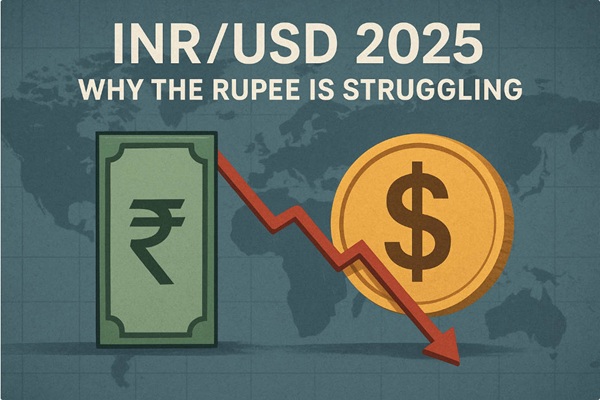Key Takeaways
Inflation remains firmly above target:
Tokyo core CPI rose 2.8 % year‑on‑year in November 2025, staying well above the BOJ's 2 % target.
Consumption shows modest resilience but lacks strength:
Household spending increased by 1.8 % in September 2025 compared with a year earlier, yet month‑on‑month adjusted spending fell 0.7 %.
Labour market remains tight but offers limited upward pressure:
Unemployment rate held at around 2.6 %, signalling continued labour demand though not necessarily strong wage acceleration.
Japan stands at a delicate crossroads. Recent data show that price pressures remain persistently high even as consumers and households navigate post‑pandemic volatility. Consumption is showing pockets of resilience, yet real‑wage erosion threatens purchasing power.
Meanwhile, the labour market stays relatively tight but wage momentum remains uneven. This complex interplay complicates the task for the Bank of Japan (BOJ), as it weighs the prospects of further rate adjustments against fragile consumption and household sentiment.
Persistent Price Pressure: Dissecting the October and November CPI Figures
| Index / Region |
Period / Month |
Year‑on‑Year Change |
Notes |
| National Core CPI (excluding fresh food) |
October 2025 |
+ 3.0% |
Highest in three months, above BOJ's 2% target |
| National "Core‑Core" CPI (excluding fresh food & fuel) |
October 2025 |
+ 3.1% |
Suggests underlying inflation strength beyond volatile items |
| Tokyo Core CPI (excluding fresh food) |
November 2025 |
+ 2.8% |
Slightly above median market forecast of 2.7%, matching October rate |
| Tokyo "Core‑Core" CPI (excluding fresh food & fuel) |
November 2025 |
+ 2.8% |
Stable from October; indicates domestically‑driven price pressures |
These figures underscore that inflation is not simply a matter of volatile fresh‑food or energy swings. Nationwide core inflation at 3.0%, and even 3.1% when excluding energy, points to more persistent price pressures.
In Tokyo, both core and core‑core inflation at 2.8% reinforce expectations that prices are rising broadly across categories rather than just in volatile sectors.[1]

Drivers Behind Inflation
Several underlying forces appear to be fueling Japan's elevated inflation:
Food price inflation, especially staples:
According to recent reports, the rise in food prices remains a central driver of Tokyo's CPI surge.
For instance, rice prices have reportedly surged significantly year‑on‑year, exerting upward pressure on household costs.
Energy and utility cost increases after subsidy adjustments:
The expiry or reduction of government energy and utility subsidies has led to higher costs for electricity, gas and other utilities, pushing up household and production expenses. That contributes significantly to the overall CPI.
Pass‑through of import and commodity costs via weak yen and global pressures:
A weaker yen tends to raise the cost of imported goods and raw materials, magnifying inflationary pressures, especially for energy, food imports, and manufactured goods — layering import‑price inflation on domestic inflation. The external cost pressure appears increasingly relevant.
Underlying demand-driven inflation creeping in:
The sustained positive inflation rates even after excluding fresh food and energy (core‑core CPI) suggest that some of the price increases may be demand‑driven.
Estimates imply firms are passing higher production or labour costs to final prices, particularly as wage and input costs rise under a tight labour market.
Implications for Underlying Inflation Trend
The convergence of headline, core, and core‑core CPI at elevated levels indicates that inflation is no longer solely a temporary spike caused by volatile items. Instead, the data suggest structural and persistent inflation pressures, a combination of cost‑push (food, energy, imports) and demand‑side elements (firms passing on costs, stable labour demand).
For the BOJ, these developments raise the prospect that modest inflation levels may endure unless countered by stronger real wages or a significant slowdown in demand. Therefore, the recent inflation readings strengthen the case for further monetary policy tightening, at least in medium‑term planning.
Retail Sales, Consumption and Real Wages Amidst Inflation

Consumption, Retail Sales and Household Spending
Although inflation remains elevated, some signs of household and retail resilience have emerged, albeit mixed. According to recent surveys:
For August 2025, households comprising two persons or more recorded a nominal increase in monthly consumption expenditure relative to the previous year, and a smaller but positive increase in real‑terms for certain segments.
Worker households saw nominal monthly income increases, although real income — after adjusting for inflation — declined, reflecting the negative real‑wage effect under persistent inflation.
The most recent data indicate that while nominal retail and industrial output showed upticks ahead of the end of the third quarter, consumer sentiment remains vulnerable to rising cost pressures.
These mixed signals reflect a consumption environment under strain: some households maintain spending, but real incomes and purchasing power remain under pressure.
Real Wage Challenge and Household Purchasing Power
As prices rise, nominal wage gains become less meaningful. In many households, although nominal pay appears stable or increasing, inflation erodes real income — reducing purchasing power and limiting discretionary spending capacity.[2]
This real‑wage squeeze discourages consumption of non‑essentials such as leisure, durable goods or luxury items, and may prompt households to draw on savings or postpone big purchases. The divergence between nominal income gains and real‑terms losses undermines consumer confidence over the medium term.
Government Stimulus, Support Measures and Consumption Prospects
To cushion the impact of high prices on households, the Japanese government has implemented targeted support measures, including subsidies and welfare reliefs.
These measures aim to mitigate the burden of inflation, especially for lower‑ to middle‑income households. However, their ability to fully offset rising costs is limited. Until real wages and purchasing power recover, broader consumption recovery remains uncertain.[2]
At present, consumption growth appears fragile and vulnerable to further price shocks or wage stagnation.
Labour Market Tightness and Wage Dynamics

Labour Market Overview
As of October 2025, the national unemployment rate stood at approximately 2.6%, marking the highest level since July 2024, though still within a tight labour‑market context.
The ratio of active job openings to job‑applicants (seasonally adjusted) remained above one — at approximately 1.20 — indicating more vacancies than job seekers, though the ratio has marginally dipped compared to previous months.[3]
Employment data show a modest increase in total employment compared with the previous year, including more regular (full‑time) employees, though non‑regular (part‑time and temporary) employee numbers have decreased.
This data suggests that labour demand continues to outpace supply, even if certain segments (e.g. non-regular workers) face pressure.
Structural Labour Shortages and Demographic Pressures
Japan's demographic challenges — an ageing population and low birth rate — have long constrained its labour supply. These structural limitations continue to exert pressure on employers across sectors such as retail, services and manufacturing.
As firms struggle to fill vacancies, competition for workers intensifies, giving rise to upward pressure on wages or benefits in order to attract and retain staff.
This structural scarcity underpins the broader wage pressure that could, over time, support sustainable inflation — if firms pass cost increases onto prices and households accept them.
Wage Growth Momentum, Seasonal Negotiations and Constraints
Wage growth in Japan has seen some upward pressure, partly driven by labour shortages and forthcoming annual wage negotiations (known as Shunto Wage Negotiations). These negotiations often set the tone for base pay raises, bonuses and benefits adjustments — critical levers for boosting real incomes.
Nevertheless, as of now, wage growth remains uneven and relatively modest. Coupled with persistent inflation, the net effect for many households may yet be negative. Without stronger, broad‑based wage gains, consumption recovery may remain constrained.
Economic Outlook and Policy Implications

The combination of persistent inflation, fragile real wages, cautious consumption, and a tight but uncertain labour market presents a policy challenge for the BOJ. Key considerations going forward include:
Inflation persistence:
With both headline and underlying inflation well above target, and with domestic demand and cost pressures intact, there is a strong case for further monetary policy tightening.
However, the BOJ must balance that against economic growth risks.
Wage‑driven growth uncertainty:
For inflation to become sustainable rather than a temporary spike, wage growth must meaningfully outpace inflation for a sustained period — a condition not yet met across the board.
Household sentiment and consumption risk:
If real‑wage erosion continues and households cut back on spending, domestic demand — a major component of GDP — may weaken, undermining growth.
External headwinds:
A weak yen, rising global commodity and import costs, and possible global demand slowdown pose further risks to import‑price inflation and export growth.
Government support and fiscal measures:
Targeted subsidies and relief programmes may ease short‑term pain, but long‑term consumption recovery depends on improving real incomes and confidence.
Given these dynamics, the BOJ is likely to adopt a cautious but data‑driven path. Further rate hikes cannot be ruled out — especially if inflation persists and wage negotiations yield meaningful pay rises. At the same time, aggressive tightening risks stifling domestic demand before consumption and wages recover sufficiently.[4]
Frequently Asked Questions
Q: What does Tokyo's 2.8% core inflation mean for the BOJ?
A: Tokyo's 2.8% core inflation signals sustained domestic price pressures above the BOJ's 2% target, increasing the likelihood of policy tightening in the near term as officials weigh inflation persistence against growth risks.
Q: Are Japanese consumers cutting back despite inflation?
A: Consumption shows modest resilience: selective spending on transport and entertainment rose, but real purchasing power is pressured by price gains, so households are cautious and spending patterns vary across income groups.
Q: Is the labour market strong enough to sustain inflation?
A: With unemployment near 2.6% the labour market is tight, supporting demand-driven inflation; however, sustained higher inflation requires stronger, broad-based wage gains, which remain uneven across sectors.
Q: Will stimulus blunt inflation or help households more?
A: The 21.3 trillion yen stimulus aims to ease household burdens and support consumption; it may cushion some near-term pain but won't immediately reverse broad inflation without improved real wage growth.
Q: Which indicators should investors watch next?
A: Watch national CPI (core and core-core), wage growth metrics, monthly household spending, Tankan sentiment, and BOJ statements — these collectively indicate whether inflation is demand-driven and likely to persist.
Conclusion
In late 2025, Japan faces persistent inflation alongside cautious household spending and uneven wage growth. The labour market remains tight, yet real incomes are pressured. Policymakers at the BOJ must balance curbing inflation with supporting consumption, as sustainable growth ultimately depends on stronger wages and renewed consumer confidence.
Sources:
[1]https://www.stat.go.jp/english/
[2]https://www.jilaf.or.jp/en/news/20251125-5920/
[3]https://www.jil.go.jp/english/estatis/esaikin/2025/e202510.html
[4]https://www.boj.or.jp/en/mopo/outlook/gor2510b.pdf
Disclaimer: This material is for general information purposes only and is not intended as (and should not be considered to be) financial, investment or other advice on which reliance should be placed. No opinion given in the material constitutes a recommendation by EBC or the author that any particular investment, security, transaction or investment strategy is suitable for any specific person.





























